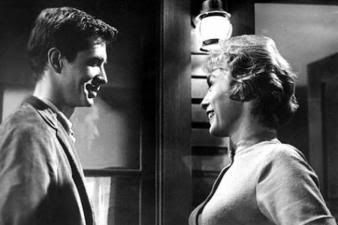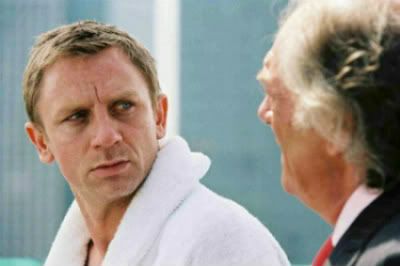
Psycho is easily one of my favorite films of all time. Sometimes I even consider it my absolute favorite film, but as a true cinema buff this kind of decision can never be made without some hesitation. So why pick Psycho out of the vast canon of cinematic achievements in history? Why even pick Psycho out of Hitchcock’s own vast canon of cinematic achievements? Most of the time, I don’t like to choose a director’s most famous film as my favorite because it feels similar to rooting for a sports team with a winning record. Making the obvious and easy choice suggests a kind of laziness on the spectator’s part and if there is one thing I am not, especially when it comes to the cinema, it’s lazy. Yet, to cast aside a cinematic gem like Psycho because it just happens to be on everyone’s top 100 list is ridiculous especially considering the relationship I have with the film.
For as long as I can remember, I have not been able to shake the effect Psycho has on me each and every time I sit down to watch it. I first saw Psycho in high school and ever since, it has felt like a part of my soul. To me it is not just a classic horror movie. It’s not even just one of the greatest films ever made. Each moment of Psycho lives in me as any mental habit or emotional tendency. In other words, I have come to know this film as though it were my own name or telephone number. This all might sound strange considering the content of Psycho and the disturbing nature of its narrative. It shouldn’t though because I am not connecting or relating to any specific character or experience within the film. I simply feel a deep admiration and fondness for the way the film is put together. I love the way the shots are so thoroughly assembled, the way each line is scripted and delivered, the strange and alluring movements of the camera, and the way Bernard Hermann’s haunting score breathes disorder, apprehension, and terror into the film.
Every scene in Psycho has its own unique effect on me but one in particular stands out and I’d like to focus on it for this critique. The scene is the one Marion Crane and Norman Bates share in the parlor of the Bates Motel. Anthony Perkins’ eerie yet vulnerable performance coupled with Hitchcock’s meticulous cuts and jarring camera angles provide a sequence that, even when compared to the shower scene that follows it, stands out as one of the most disturbing and flawlessly constructed of the film.
The scene begins with Norman and Marion pleasantly conversing. They engage mainly in small talk and Norman comes across as lonely and self-effacing but not at all threatening. Marion attempts to better understand Norman and his life. The cinematography, like the conversation itself, is rather conventional. Both Norman and Marion are framed head-on in a medium shot, and there is nothing particularly off-putting about the camera angle or shot scale. Suddenly the conversation switches gears when Marion mentions Norman’s mother and the change in topic is accompanied by a change in camera set-up.
Marion expresses her dismay over the way she heard Norman’s mother speak to him when he was making supper. The camera angle has changed considerably and Norman is now seen from the side. The camera has also been placed somewhat below him so that he appears to hover over us much like the stuffed birds on the wall of the parlor. There is no real reason why the angle should change at this point. In other words, there is no dramatic motivation for it. Normally when the drama of the scene is intensified, the camera will move closer to a character but the position and angle will remain the same. The changes in position and angle seem to instead correlate to Norman’s change in mind-set.
Norman’s mother is clearly a disconcerting subject for Norman as is evidenced by the peculiar way Hitchcock has chosen to frame Norman while he describes his relationship with her. Norman tiptoes around an explanation of why his mother is so hostile and possessive almost as though he is afraid she will hear him. He retracts many of his statements and contradicts himself a number of times. It is difficult to grasp why Norman is unable to articulate his feelings about his mother and the unusual way he appears in the frame only heightens our uncertainty. While it is important for him to appear creepy and strange, what is most crucial is that we develop a strong enough curiosity about Norman to truly care about the fate of his character. By presenting him in such an atypical manner, Hitchcock gives Norman an exclusivity that is absolutely essential within the greater context of the film.
After listening attentively to Norman’s admissions, Marion looks at Norman, genuinely concerned. Attempting to express this concern, she says to Norman, “Wouldn’t it be better if you put her…some place?” When we cut to Norman, he is suddenly seen straight on in a near close-up. He occupies the right side of the frame while another stuffed bird hanging on the wall in the background occupies the left side. Norman sits up to fill the center of the frame and is clearly infuriated by Marion’s question. He retorts, “You mean an institution? A madhouse? People always call a madhouse ‘some place,’ don’t they? Put her in ‘some place.’” He expresses to Marion the cruel and hideous nature of asylums and consequently berates her for even suggesting it. When we cut to Marion, she is obviously alarmed by Norman’s change in behavior. Clearly she was not expecting shy, awkward Norman Bates to react so aggressively.
With each change in camera position and shot scale, we see Norman edging closer and closer to complete insanity. But just as easily as he can slip into madness, he can snap back into reality. After lashing out at Marion, Norman suddenly leans back in his chair as if he has just come out of a trance. He says, “Of course I have suggested it myself,” in regards to putting his mother in an institution, and it now seems as though he agrees with Marion. Again we see Norman contradicting himself as though he is trying to regain control of his own thoughts. What is unsettling about Norman’s transformation is not the erratic behavior that it produces but rather how quickly and effortlessly the transformation occurs. The way Norman’s voice, posture, and attitude change in a matter of moments is both terrifying and hypnotic, and Hitchcock, with his impeccable eye for detail, is able to capture all of it without missing a beat.
Upon one’s first viewing of this scene, the sudden changes in camera placement and shot scale appear odd and inexplicable. Only when we discover Norman’s true self do we understand why Hitchcock made such deliberate stylistic choices. Norman Bates’ mind has been fragmented by his mental illness so what better way to illustrate this than to fragment his presentation on screen. While the shot scale and camera positions also change in regards to Marion, these changes are minute and subtle and would likely occur in any conventional dramatic scene. In other words, there is nothing particularly special about them. Marion’s role in this scene is meant to be secondary to Norman’s and thus Hitchcock illustrates this with the cinematography. After Marion is abruptly extracted from the film only a third of the way through and she is no longer the central figure, it becomes necessary for the audience to align itself with another character. Therefore, Hitchcock’s cinematographic emphasis of Norman in the parlor scene becomes especially important because through the scene Hitchcock not only draws our attention to Norman but also instills in us a curiosity that will motivate our allegiance to him.
So whether you have seen Psycho dozens of times or you are watching it for the first time, pay close attention to the scene in the parlor and the way it shapes the character of Norman Bates. Resist any temptation to dismiss all of the subtle nuances that lead up to the shower scene. Pop culture may have taught us that the big payoff of Psycho is seeing Janet Leigh stabbed maniacally to the sound of screeching violins, but I've discovered otherwise. While the shower scene is an enormously important one in cinema history for the way it shattered classical Hollywood conventions, it is not the most frightening one in the film. What is more terrifying than even the gruesome slaughter of Marion Crane is the way we are manipulated into sympathizing with the man responsible for it.
*Nominated for four Academy Awards including Best Supporting Actress, Best Art Direction-Set Decoration (Black-and-White), Best Cinematography (Black-and-White), and Best Director.


